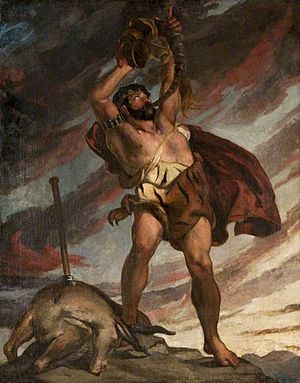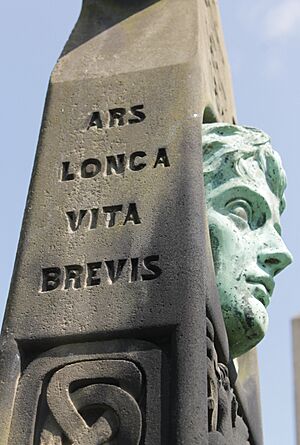David Scott (painter) facts for kids

David Scott (born October 1806 – died 5 March 1849) was a talented Scottish artist. He was known for painting historical scenes and imaginative pictures.
Contents
Who Was David Scott?
David Scott was born in October 1806 in Edinburgh, Scotland. He was the brother of another artist, William Bell Scott. David grew up in a creative family. His father, Robert Scott, was an engraver, and David learned art from him. He also went to the Royal High School in Edinburgh.
Early Artworks
David Scott showed his first oil painting in 1828. It was called "Hopes of Early Genius dispelled by Death." He then painted other imaginative works. These included "Cain," "Nimrod," and "Adam and Eve singing their Morning Hymn." His early paintings often had deep, poetic meanings.
Becoming a Member of the Scottish Academy
In 1829, David Scott became a member of the Scottish Academy. This was an important step for his art career. It showed that other artists recognized his talent.
Travels and Later Works
In 1832, David Scott traveled to Italy. He spent over a year there, studying art and history. While in Rome, he created a large painting called "The Agony of Discord, or the Household Gods Destroyed."
Some of his most famous later paintings include:
- "Vasco da Gama encountering the Spirit of the Storm" (1842): This huge painting shows the explorer Vasco da Gama meeting a storm spirit. It is now kept in the Trinity House, Leith.
- "The Duke of Gloucester entering the Water Gate of Calais" (1841): This painting shows a historical scene.
- "Queen Elizabeth at the Globe Theatre" (1840): This work is known for its detailed characters.
- "Ariel and Caliban" (1837) and "The Triumph of Love" (1846): These paintings are admired for their beautiful colors and deep feelings.
He also painted important religious scenes. These include "The Descent from the Cross" (1835) and "The Crucifixion the Dead Rising" (1844).
Illustrations and Designs
Besides paintings, David Scott also created many amazing designs.
- He etched two series of designs himself. One was called "Monograms of Man." The other was illustrations for Coleridge's famous poem, The Rime of the Ancient Mariner. These were published in 1831 and 1837.
- After he passed away, his illustrations for The Pilgrim's Progress were published. He also created designs for Nichol's Architecture of the Heavens.
His Final Years
David Scott lived in Stockbridge, Edinburgh, at 5 Mary Place. Later, he leased a studio at Easter Dalry House. He became ill after his trip to Italy and passed away on 5 March 1849.
He was buried in Dean Cemetery in Edinburgh. His brother designed a special monument for his grave in 1860. The monument has a Latin saying: "ars longa vita brevis." This means "Art is long, life is short." It reminds us that art can last forever, even if a person's life is short.
His painting "Vasco de Gama at the Cape of Good Hope" is considered his greatest work. It is displayed at Trinity House of Leith.
Images for kids
-
Nimrod by David Scott, 1832




